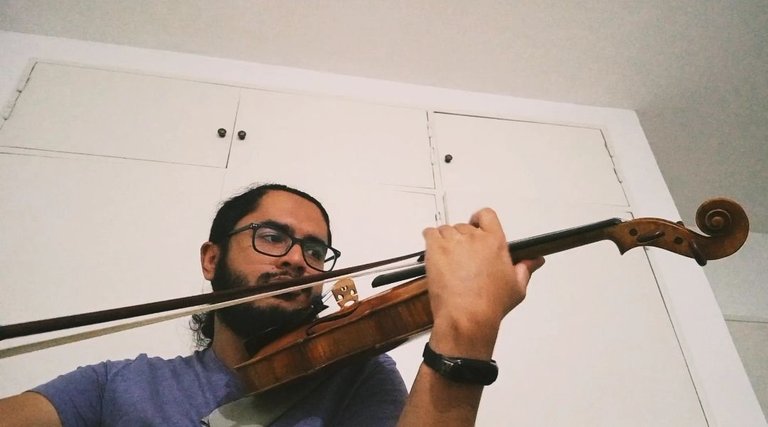
Hola queridos y apreciados amigos, espero cómo es de costumbre estén muy pero muy bien, con mucha salud
Hoy quiero continuar mi ciclo de publicaciones con algo ya no tan teórico, sino más hacia lo musical,
Anteriormente venía trayendoles cosas quizás más humanas cómo lo es el estudio para preparación hacía audiciones o exámenes, y cosas muy teóricas cómo las obras en tres tiempos,
Ésta vez tocaré un tema quizás muy general, pero que es importante recalcar porque ya de por sí, nuestras emociones hacen que de la música saquemos sentimientos o de los sentimientos saquemos música,
En éste caso hablaremos lo que es la adrenalina, la intensidad y el carácter en la música de violín,
Primeramente es importante recalcar que la única manera de transmitir emociones en la música es con la parte armónica, es decir, el juego de acordes, de tonalidades y de matices... Es si o si, la única forma,
Ejemplo, si en una sinfonía suena un "laaaaaa" en los violines, éste no va a tener mucho significado... Va a ser casi simple,
Pero si tenemos un "laaa" en los violines y los demás instrumentos recalcan un acorde de La Mayor, notaremos cómo el sentido de esos sonidos es algo alegre, algo muy contento.
Ahora, además de la parte armónica, que abarca para todos los instrumentos, pues cada uno tiene rasgos diferentes para transmitir ese algo, cómo por ejemplo,
En el violín o los instrumentos cómo el cello, la viola, el contrabajo, etc, podemos usar el arco a nuestro favor. Podemos hacer acentos, tocar fuerte, tocar piano, etc, cosa que por lo menos los oboes lo aplican pero desde el aire (por no tener un arco)
Es por esa razón que en el vídeo de hoy escucharemos un fragmento de uno de los conciertos de Vieuxtemps dónde la adrenalina es transmitida por el violín:
Desde el comienzo se hacen presentes unos acentos, que van dándole mucha intensidad al juego de los registros,
En pocas palabras comienza un poco agudo y va hacia lo grave, cómo si se tratase de algo que va hacia algo muy dentro, algo que tiene mucha presencia,
Es por ello que existe en éste fragmento el juego de las notas agudas y las graves, además que luego repite el mismo tema pero mucho más asentado, cómo si se tratara de afirmar algo. Afirmar la misma intensidad,
Luego, aparece repentinamente un arpegio que conlleva a un armónico agudo, para volver a las notas graves, terminando con cierta sorpresa.
Así que sin más qué agregar por hoy espero les haya gustado, y disfruten de ésta pequeña explicación que les traje, ¡Abrazos!
/

Hello dear and appreciated friends, I hope as usual you are very, very well, in good health
Today I want to continue my cycle of publications with something not so theoretical, but more towards the musical,
Previously, I had been bringing you things that were perhaps more human, such as studying to prepare for auditions or exams, and very theoretical things, such as works in three beats,
This time I will touch on a topic that is perhaps very general, but it is important to emphasize because our emotions already make us get feelings out of music or music out of feelings,
In this case we will talk about adrenaline, intensity and character in violin music,
Firstly, it is important to emphasize that the only way to transmit emotions in music is with the harmonic part, that is, the game of chords, tonalities and nuances... It is yes or yes, the only way,
For example, if a "laaaaaa" sounds on the violins in a symphony, it won't have much meaning... It will be almost simple,
But if we have a "laaa" in the violins and the other instruments emphasize an A Major chord, we will notice how the meaning of those sounds is somewhat happy, something very happy.
Now, in addition to the harmonic part, which covers all the instruments, since each one has different features to transmit that something, like, for example,
In the violin or instruments such as the cello, the viola, the double bass, etc, we can use the bow in our favor. We can do accents, play loud, play piano, etc, something that at least the oboes apply but from the air (for not having a bow)
It is for this reason that in today's video we will listen to a fragment of one of the Vieuxtemps concerts where the adrenaline is transmitted by the violin:
From the beginning some accents are present, which give great intensity to the game of registers,
In a few words, it starts out a bit sharp and goes towards the serious, as if it were something that goes towards something deep inside, something that has a lot of presence,
That is why there is in this fragment the game of high and low notes, in addition to later repeating the same theme but much more settled, as if it were about affirming something. Affirm the same intensity,
Then, an arpeggio suddenly appears, leading to a high harmonic, to return to the low notes, ending with some surprise.
So without more to add for today I hope you liked it, and enjoy this little explanation that I brought you, Hugs!
Congratulations @gregorior! You have completed the following achievement on the Hive blockchain and have been rewarded with new badge(s):
Your next target is to reach 46000 upvotes.
You can view your badges on your board and compare yourself to others in the Ranking
If you no longer want to receive notifications, reply to this comment with the word
STOPCheck out the last post from @hivebuzz:
Support the HiveBuzz project. Vote for our proposal!